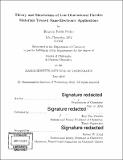Theory and simulations of low-dimensional flexible materials toward nano-electronic applications
Author(s)
Pablo Pedro, Ricardo
DownloadFull printable version (12.47Mb)
Other Contributors
Massachusetts Institute of Technology. Department of Chemistry.
Advisor
Troy Van Voorhis.
Terms of use
Metadata
Show full item recordAbstract
In this thesis, we develop new theories and perform simulations to study low dimensional materials such as directed polymers (1+1 dimension) and silicene nanoclusters (0 dimension) that can be used for nanotechnology applications. In recent years, there has been a flurry of experimental and theoretical activities aimed at exploring topological insulators in classical contexts. The aim is to develop novel types of robustness within optical and mechanical materials. Virtually all of these proposals and experiments rely on wave propagation described by Newton's or Maxwell's equations and for the most part ignore interactions between particles or waves. In the first three chapters of this thesis, we explore whether it is possible to adopt similar strategies at the scale of soft materials where transport is typically governed by diffusion processes rather than wave propagation (sound waves are typically suppressed by dissipation). Moreover, in soft materials, thermal fluctuations and interactions are strong and cannot be neglected. We present a general strategy to create topologically protected gapped states in soft matter systems described by the diffusion equation with the presence of strong many-body interactions. We apply our framework to a system of many interacting polymers on a spatially modulated substrate. In this case, the topologically protected state is not a wave robustly moving along the edge of the finite systems, but rather a tilt in the collective orientation of the polymer liquid. The resulting tilt angle is proportional to a topological index called Chern number, and thereby exhibits robustness against substrate disorder. We corroborate these conclusions with numerical simulations. The miniaturization of electronics will depend on our capability to engineer nanoscaled hetero-structures. Therefore, our study on the rest of this thesis focuses on the electronic and magnetic properties of finite rectangular silicene fragments to which we refer as silicene nanoclusters. We use first-principles calculations to demonstrate that the multiplicity of the the ground (neutral) state of a silicene nanocluster (SiNC) is determined by the nature of its nanoribbon edges (i.e. armchair na or zigzag nz,). For instance, a rectangular SiNC with edges na > nz, has a nonzero net spin, resembling an artificial ferromagnetic state. In addition, we calculate the Raman spectra which allowed us to detect a D peak, which is given by the armchair edges with a triplet ground state. In general, this principle of varying the length of the SiNCs can be used to introduce large net spin as well as interesting spin distributions in silicene. The observation of a triplet ground state in the armchair edges can be used for the design of spintronic devices. High-performance materials rely on small reorganization energies to facilitate both charge separation and charge transport. Here, we found that rectangular SiNCs could have small reorganization energies depending on the multiplicity of the ground state of the SiNC. These rectangular SiNCs feature large electron affinities and highly stabilized anionic states indicating that these finite structures are prone to behave as n-type semiconductors that could be used in low dimensional hetero-junctions. Moreover, we discovered a possible connection between the energy response of the material with the distortion of its buckled lattice which would be advantageous to consider while designing such electronic devices.
Description
Thesis: Ph. D. in Physical Chemistry, Massachusetts Institute of Technology, Department of Chemistry, 2018. Cataloged from PDF version of thesis. Includes bibliographical references (pages 141-158).
Date issued
2018Department
Massachusetts Institute of Technology. Department of ChemistryPublisher
Massachusetts Institute of Technology
Keywords
Chemistry.